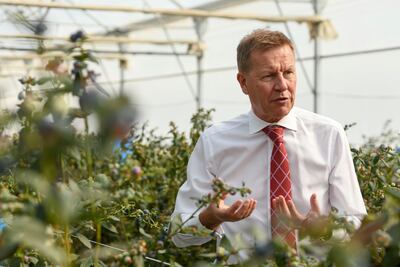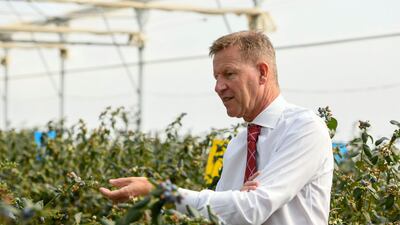Down a dirt track off the Dubai-Al Ain Road, in one of the UAE’s greenest regions, you will find a sprawling farm that is home to some of the tastiest berry selections.
Bumblebees imported from Europe help to pollinate thousands of berry bushes at Al Foah Farm in Al Ain, with about 1,500 bees per hectare working furiously between the planting and harvesting months.
The farm, owned and operated by Elite Agro Holding, leads the local production of some of nature’s best superfoods including raspberries, blackberries, and strawberries.
Localisation is our unique selling point. You can’t get fresher than this
Ian Summerfield,
Elite Agro
But it also holds the title of being the only steading in the country growing blueberries.
“Berries are fascinating because they have such a short shelf life but have become super popular with consumers in recent years,” said Ian Summerfield, chief executive of Elite Agro.
“Localisation is our unique selling point. You can’t get fresher than this.
“We operate something called the triple two policy.
“Taking the berries from harvest to cool storage takes less than two hours, the berries are only touched by two hands; the picker and the consumer, and we store all our produce at 2°C to keep it fresh.”
Large greenhouses fitted with water-based cooling systems house thousands of plants and bushes where the berries are in full bloom throughout their given season.
Blueberries are usually harvested from January to May and raspberries and blackberries from October to April.
Twenty greenhouses dedicated to blueberry production cover a total area of 12 hectares, with an average of 5,400 blueberry plants per hectare.
Raspberry and blackberry production is smaller in scale, covering a total area of 1.8 hectares and 1.2 hectares, respectively.
The farm is home to four premium varieties of blueberries ― dazzle, eureka, eureka sunrise and first blush. The plants are brought in from a breeder in Australia called Mountain Blue Orchard.
In terms of taste profile, Mr Summerfield said the blueberries have a "sweet but sharp flavour, are larger in size than most and have a crunchy texture".
“We had to find berries that could cope with this climate but still give a great burst of flavour,” he said.
“In 2017 we signed an exclusivity deal with Mountain Blue Orchard as we found these varieties would be best for this market both for flavour, texture and size but also for the growing conditions we had.
“We are the largest and only blueberry growers in the UAE and we’re the only people allowed to grow these varieties of berries in the Middle East.”
Fruitful production annually
During harvest, the blueberries are picked three times a week by farmhands and reach retail shelves within 24 hours.
Depending on where you shop, a 500g punnet of Elite blueberries, can cost between Dh30 to Dh40.
Annually, the farm produces about 300 tonnes of blueberries, 70 tonnes of raspberries and 30 tonnes of blackberries across tens of hectares of greenhouse spaces.
Over the next few years, Mr Summerfield said the farm will expand its blueberry crop by 13 hectares, meaning by 2026 it will produce close to 700 tonnes of blueberries a year.
How do you grow the perfect blueberry?
Blueberries have very specific pH requirements, so the saplings are planted in coco peat, made from coconut husks, and perlite, a naturally occurring mineral.
A drip system, which distributes a combination of water and fertiliser, is used for each plant and it receives about 3.5 litres of water per day in the hot summer months and only one litre during the cooler winter season.
For pollination, each flower on the plant needs to be visited by a bee between 18-23 times in a season, and each plant has around 1,600 flowers.
To keep pests at bay, the farm also introduces insect predators to kill unwanted bugs as an alternative to using harmful and costly pesticides.
Mr Summerfield said the biggest pest is a tiny insect called thrip and they bring in beetles to kill them off.
Spread across 570 hectares of land, the farm also produces peppers, tomatoes, cucumbers and potatoes.
In Search of Mary Shelley: The Girl Who Wrote Frankenstein
By Fiona Sampson
Profile
Company%C2%A0profile
%3Cp%3E%3Cstrong%3ECompany%20name%3A%20%3C%2Fstrong%3ELeap%0D%3Cbr%3E%3Cstrong%3EStarted%3A%20%3C%2Fstrong%3EMarch%202021%0D%3Cbr%3E%3Cstrong%3EFounders%3A%3C%2Fstrong%3E%20Ziad%20Toqan%20and%20Jamil%20Khammu%0D%3Cbr%3E%3Cstrong%3EBased%3A%3C%2Fstrong%3E%20Dubai%0D%3Cbr%3E%3Cstrong%3ESector%3A%20%3C%2Fstrong%3EFinTech%0D%3Cbr%3E%3Cstrong%3EInvestment%20stage%3A%20%3C%2Fstrong%3EPre-seed%0D%3Cbr%3E%3Cstrong%3EFunds%20raised%3A%3C%2Fstrong%3E%20Undisclosed%0D%3Cbr%3E%3Cstrong%3ECurrent%20number%20of%20staff%3A%20%3C%2Fstrong%3ESeven%3C%2Fp%3E%0A
In-demand jobs and monthly salaries
- Technology expert in robotics and automation: Dh20,000 to Dh40,000
- Energy engineer: Dh25,000 to Dh30,000
- Production engineer: Dh30,000 to Dh40,000
- Data-driven supply chain management professional: Dh30,000 to Dh50,000
- HR leader: Dh40,000 to Dh60,000
- Engineering leader: Dh30,000 to Dh55,000
- Project manager: Dh55,000 to Dh65,000
- Senior reservoir engineer: Dh40,000 to Dh55,000
- Senior drilling engineer: Dh38,000 to Dh46,000
- Senior process engineer: Dh28,000 to Dh38,000
- Senior maintenance engineer: Dh22,000 to Dh34,000
- Field engineer: Dh6,500 to Dh7,500
- Field supervisor: Dh9,000 to Dh12,000
- Field operator: Dh5,000 to Dh7,000
The specs: 2018 Maserati Levante S
Price, base / as tested: Dh409,000 / Dh467,000
Engine: 3.0-litre V6
Transmission: Eight-speed automatic
Power: 430hp @ 5,750rpm
Torque: 580Nm @ 4,500rpm
Fuel economy, combined: 10.9L / 100km
Desert Warrior
Starring: Anthony Mackie, Aiysha Hart, Ben Kingsley
Director: Rupert Wyatt
Rating: 3/5
Dubai World Cup prize money
Group 1 (Purebred Arabian) 2000m Dubai Kahayla Classic - $750,000
Group 2 1,600m(Dirt) Godolphin Mile - $750,000
Group 2 3,200m (Turf) Dubai Gold Cup – $750,000
Group 1 1,200m (Turf) Al Quoz Sprint – $1,000,000
Group 2 1,900m(Dirt) UAE Derby – $750,000
Group 1 1,200m (Dirt) Dubai Golden Shaheen – $1,500,000
Group 1 1,800m (Turf) Dubai Turf – $4,000,000
Group 1 2,410m (Turf) Dubai Sheema Classic – $5,000,000
Group 1 2,000m (Dirt) Dubai World Cup– $12,000,000
%E2%80%98FSO%20Safer%E2%80%99%20-%20a%20ticking%20bomb
%3Cp%3EThe%20%3Cem%3ESafer%3C%2Fem%3E%20has%20been%20moored%20off%20the%20Yemeni%20coast%20of%20Ras%20Issa%20since%201988.%3Cbr%3EThe%20Houthis%20have%20been%20blockading%20UN%20efforts%20to%20inspect%20and%20maintain%20the%20vessel%20since%202015%2C%20when%20the%20war%20between%20the%20group%20and%20the%20Yemen%20government%2C%20backed%20by%20the%20Saudi-led%20coalition%20began.%3Cbr%3ESince%20then%2C%20a%20handful%20of%20people%20acting%20as%20a%20%3Ca%20href%3D%22https%3A%2F%2Fwww.google.ae%2Furl%3Fsa%3Dt%26rct%3Dj%26q%3D%26esrc%3Ds%26source%3Dweb%26cd%3D%26ved%3D2ahUKEwiw2OfUuKr4AhVBuKQKHTTzB7cQFnoECB4QAQ%26url%3Dhttps%253A%252F%252Fwww.thenationalnews.com%252Fworld%252Fmena%252Fyemen-s-floating-bomb-tanker-millions-kept-safe-by-skeleton-crew-1.1104713%26usg%3DAOvVaw0t9FPiRsx7zK7aEYgc65Ad%22%20target%3D%22_self%22%3Eskeleton%20crew%3C%2Fa%3E%2C%20have%20performed%20rudimentary%20maintenance%20work%20to%20keep%20the%20%3Cem%3ESafer%3C%2Fem%3E%20intact.%3Cbr%3EThe%20%3Cem%3ESafer%3C%2Fem%3E%20is%20connected%20to%20a%20pipeline%20from%20the%20oil-rich%20city%20of%20Marib%2C%20and%20was%20once%20a%20hub%20for%20the%20storage%20and%20export%20of%20crude%20oil.%26nbsp%3B%3C%2Fp%3E%0A%3Cp%3EThe%20%3Cem%3ESafer%3C%2Fem%3E%E2%80%99s%20environmental%20and%20humanitarian%20impact%20may%20extend%20well%20beyond%20Yemen%2C%20experts%20believe%2C%20into%20the%20surrounding%20waters%20of%20Saudi%20Arabia%2C%20Djibouti%20and%20Eritrea%2C%20impacting%20marine-life%20and%20vital%20infrastructure%20like%20desalination%20plans%20and%20fishing%20ports.%C2%A0%3C%2Fp%3E%0A
What drives subscription retailing?
Once the domain of newspaper home deliveries, subscription model retailing has combined with e-commerce to permeate myriad products and services.
The concept has grown tremendously around the world and is forecast to thrive further, according to UnivDatos Market Insights’ report on recent and predicted trends in the sector.
The global subscription e-commerce market was valued at $13.2 billion (Dh48.5bn) in 2018. It is forecast to touch $478.2bn in 2025, and include the entertainment, fitness, food, cosmetics, baby care and fashion sectors.
The report says subscription-based services currently constitute “a small trend within e-commerce”. The US hosts almost 70 per cent of recurring plan firms, including leaders Dollar Shave Club, Hello Fresh and Netflix. Walmart and Sephora are among longer established retailers entering the space.
UnivDatos cites younger and affluent urbanites as prime subscription targets, with women currently the largest share of end-users.
That’s expected to remain unchanged until 2025, when women will represent a $246.6bn market share, owing to increasing numbers of start-ups targeting women.
Personal care and beauty occupy the largest chunk of the worldwide subscription e-commerce market, with changing lifestyles, work schedules, customisation and convenience among the chief future drivers.
The%20specs
%3Cp%3E%3Cstrong%3EEngine%3A%20%3C%2Fstrong%3E2.0-litre%204-cyl%20turbo%3Cbr%3E%3Cstrong%3EPower%3A%20%3C%2Fstrong%3E190hp%20at%205%2C600rpm%3Cbr%3E%3Cstrong%3ETorque%3A%20%3C%2Fstrong%3E320Nm%20at%201%2C500-4%2C000rpm%3Cbr%3E%3Cstrong%3ETransmission%3A%20%3C%2Fstrong%3E7-speed%20dual-clutch%20auto%3Cbr%3E%3Cstrong%3EFuel%20consumption%3A%20%3C%2Fstrong%3E10.9L%2F100km%3Cbr%3E%3Cstrong%3EPrice%3A%20%3C%2Fstrong%3EFrom%20Dh119%2C900%3Cbr%3E%3Cstrong%3EOn%20sale%3A%20%3C%2Fstrong%3ENow%3C%2Fp%3E%0A













